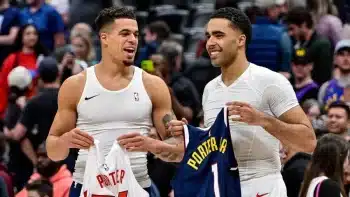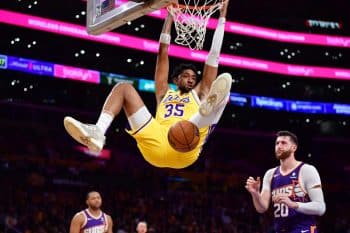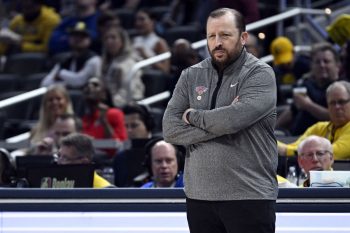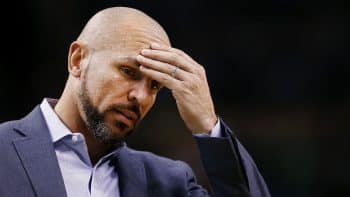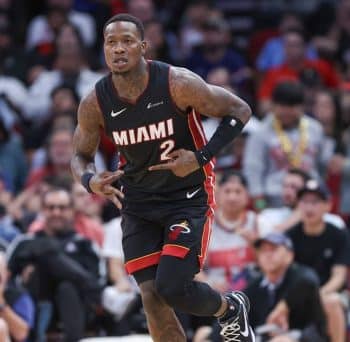NBA
NBA Sunday: Bradley Beal Leads the Changing of the Shooting Guard

It was one of the more frigid January nights in the nation’s capital, but inside of Washington, D.C.’s Verizon Center ensued a battle that nary a paying customer believed they would witness.
It was 2013 and the 4-28 Washington Wizards were seen as nothing more than an undisciplined bunch being led by John Wall—another entitled pro athlete who was given too much, too soon.
Kevin Durant—the man whose homecoming this night was—was the opposite.
Durant was the quintessential stud. Hard working, dedicated to his craft and doing whatever was necessary to win. As a resident of the Western Conference, he was making his annual trip to the District of Columbia.
Unfortunately for him, a rookie shooting guard that few had ever heard of ruined it; some kid named Bradley Beal.
Out of necessity, Beal had become the alpha and omega of the Wizards’ offensive repertoire. He had the requisite skills: a quick first step, good ball handling ability, a dead-eye jumper and passing accuracy, but not the experience.
The problem? Wall, who would normally have ball-handling and play calling duties, was diagnosed with a stress injury to his left knee four months earlier. And to this point, for head coach Randy Wittman, the results weren’t reassuring. The Wizards sputtered out to a 4-28 record, were staring at the prospect of another lost season, and were now welcoming the defending Western Conference Champion Thunder into their building.
But on this night, Beal stole the show—especially when it mattered most.
After Durant tied the game on a 24-foot three-pointer, with 12.2 seconds remaining, it was Beal who coach Wittman entrusted with the game.
He was initially denied the ball when he cut diagonally from the three-point arc to the sideline, but would eventually receive at mid-court, isolated against Sefolosha. Kendrick Perkins—who was guarding Kevin Seraphin—attempted to trap Beal after Seraphin set a screen for him and rolled to the rim.
For a split second, Beal looked apprehensive. Dribbling to his right, then to his left. He stepped inside of the three-point line, picked up his dribble and pump-faked Perkins into next week.
Pivoting with his right foot, Beal stepped in and past Perkins’ outstretched arm and released an off-balanced, leaning 16-footer. Perkins nearly recovered in time, slightly bumping Beal as he released, but Beal’s introduction to the NBA would not be thwarted.
To this point, Beal had made some clutch shots for his Wizards, but none against this level of competition and under such difficult game conditions.
I remember on that night—as a rookie playing just his 33rd professional game—believing that Beal was special. Off the top of my head, the only other rookie shooting guards that I could recall exuding the same type of confidence and ability to control a game with such poise were Vince Carter and Dwyane Wade.
If Beal is lucky, he may one day be mentioned in a conversation along either of those two greats. One shot doesn’t make a career, but I have always been of the opinion that it could reveal something about a player.
One game doesn’t make you a Hall-of-Famer, but one game and one performance can show that you have the potential to get there one day.
This was Beal’s night.
—
The most difficult thing an NBA general manager has to do is make player personnel decisions. He determines which players he pays and which players he drafts. He rolls the dice, often having his correct decisions forgotten about and rarely credited and his mediocre or poor ones questioned. Fortunately, over the course of the previous two Collective Bargaining Agreements, the league has added mechanisms to protect against paying for a mistake for an inordinate amount of time.
No longer will a general manager have to pay the likes of Eddy Curry or Erick Dampier for six or seven years.
There is a similar protective mechanism against drafting the wrong player. Only the first two years of a player’s rookie contract is guaranteed, meaning that a general manager can cut bait after two seasons if he is willing to admit that he made a mistake. It rarely happens, but the Milwaukee Bucks did exactly that with Joe Alexander—the eighth overall pick of the 2010 draft.
However, although a general manager doesn’t necessarily pay for a mistake for as long as he did once upon a time, the price and regret of lost opportunity? It cuts deep.
Back in 2005, the Atlanta Hawks selected Marvin Williams with the second overall pick in the draft. Billy Knight, the general manager at the time, opted for Williams over both Chris Paul and Deron Williams, despite the fact that the club desperately needed a spry point guard prospect.
Similarly, the very next year, in 2006, the Chicago Bulls drafted LaMarcus Aldridge with the second overall pick. That was a good idea.
The Bulls then traded Aldridge to the Portland Trail Blazers for a package built around Tyrus Thomas, who was selected fourth overall.
(Not such a good idea)
The Bulls only paid Thomas for three full years, opting to trade him during his fourth season.
Although the drafting of Williams by the Hawks and the acquiring of Thomas by the Bulls were not horrible basketball decisions based on the talent either player, they become atrocities when viewed in hindsight.
Would the Hawks have been better off with Chris Paul? Would the Bulls have fared better with LaMarcus Aldridge? Of course.
Years later, we now know, in each situation, what would have been the “better” decision.
As it relates to Beal, the theory is quite simple.
As a general manager, you are very likely to know whether you made a wise decision on a player during their first season as a professional. Obviously, the player needs to be given an opportunity to showcase his talents. Some coaches are simply not fond of giving youngsters copious amounts of playing time, often believing that it takes two to three years of riding pine to figure out the NBA game.
So occasionally, yes, you will run into examples like Jermaine O’Neal or Jeremy Lin—guys who legitimately had little opportunity to showcase their talents before proving themselves years after their careers began.
But for the most part—a promising younger player, especially one selected with a lottery pick—will get opportunities to go out there and show the world why he is in the league.
And if that player has the potential to be elite—if he has the potential to be an impact player who can one day lead a team and put it on his shoulders—that is something that will be seen quickly after the player has his opportunity.
What separates the players from the stars and the superstars is consistency. Superstars show up every single night and find ways to impact games, no matter what. That is a skill that takes time to develop. But from the very beginning, even in spurts or sporadic occasion, the flash should avail.
So on January 7, 2013, as the basketball world watched, I was not yet convinced that Beal had that trait, but by the end of the night, when his Wizards prevailed 101-99, I did.
Common, the acclaimed hip hop recording artist and actor who hails from Chicago, said it best in The Light, one of contemporary hip hop’s better love ballads.
Granted, we known each other for some time
it don’t take a whole day to recognize sunshine
In other words, I can look out my window and see whether the sun is shining, just like I can see how you conduct yourself, lead your team and handle the final possession and shot of a competitive game and know whether or not you belong in this league.
Today, if you ask Durant about his feelings on Beal, the first thing Durant will probably recall is that cold winter night in 2013. In the grand scheme, it was just one game, but when asked specifically about Beal, most who attended would remember it as the night when his discernible light began to glisten brightly enough for all to notice.
—
Over the next 15 months, Wall would return and Beal would continue to progress, improving on both his catch-and-shoot proficiency as well as his one-step dribble pull-up. Before our very eyes, the tandem has transformed into one of the top young backcourts in the entire league, right along the likes of the Golden State Warriors’ Klay Thompson and Stephen Curry.
In April 2014, with the ever-improving Beal and Wall’s marked improvements, the Wizards qualified for the playoffs for the first time since 2008. They would defeat the Chicago Bulls in the first round and win a playoff series for the first time since 2005.
In the playoffs, Beal led the team with 19.2 points per game on a blistering 41.5 percent three-point connection rate. He added five rebounds and 4.5 assists per game—nothing short of outstanding for a sophomore shooting guard making his first playoff appearance.
As Beal is set to begin his third season, recall that impact NBA players traditionally make leaps in their junior years. The eyes and expectations are firmly on the Wizards and especially Beal. Although he is expected to be sidelined for the first six-to-eight weeks of the season with a non-displaced fracture in his left wrist, he will eventually emerge as the team’s alpha-scorer, once again.
With Klay Thompson and James Harden, Beal is one of the three talented young shooting guards that are toiling and, maybe, ending the drought that the league has had there for what seems like a long, long time.
In 1996, Kobe Bryant and Ray Allen entered the NBA. Vince Carter (1998), Richard Hamilton and Manu Ginobili (both 1999) came shortly thereafter. Joe Johnson entered in 2001 and Dwyane Wade in 2003.
In 2004, Andre Iguodala emerged and the following year, in 2005, was Brandon Roy.
It wasn’t until 2009—when James Harden and DeMar DeRozan entered the league—that we began seeing newfound strength at the position. In 2011, Klay Thompson entered the league and in 2012 came Beal.
Looked at differently, since 1996, only three classes have featured more than one shooting guard who would become an All-Star. Bryant and Allen of 1996, Hamilton and Ginobili of 1998 and Harden and DeRozan of 2009.
In total, Bryant (16), Allen (10), Wade (10), Carter (8) and Johnson (7) combine for 51 NBA All-Star Game appearances. Wade is the only shooting guard on that list that was drafted within the past 12 years. The longevity and sustained greatness of this past generation of shooting guards is a major reason why, but the truth of the matter is that they haven’t exactly been pushed by the past decade’s incoming crop of shooting guards.
—
Today, the tide is turning.
The league may currently be in its golden age of the point guard, but the Beal is making his mark as a true shooting guard who has All-NBA potential. With him, the future of the Washington Wizards is far from bleak.
Like that cold January night back in 2013, eyes are on Beal, but for a different reason. With his flashes and his impressive all-around ability to control a game, the Wizards will build a better tomorrow upon the success of yesterday.
They will do so on the capable shoulders of one of the best third-year shooting guards this league has seen in quite some time.
They do so with Bradley Beal—a rare impact shooting guard whose star shines as brightly as any we have seen over, perhaps, the past decade.
